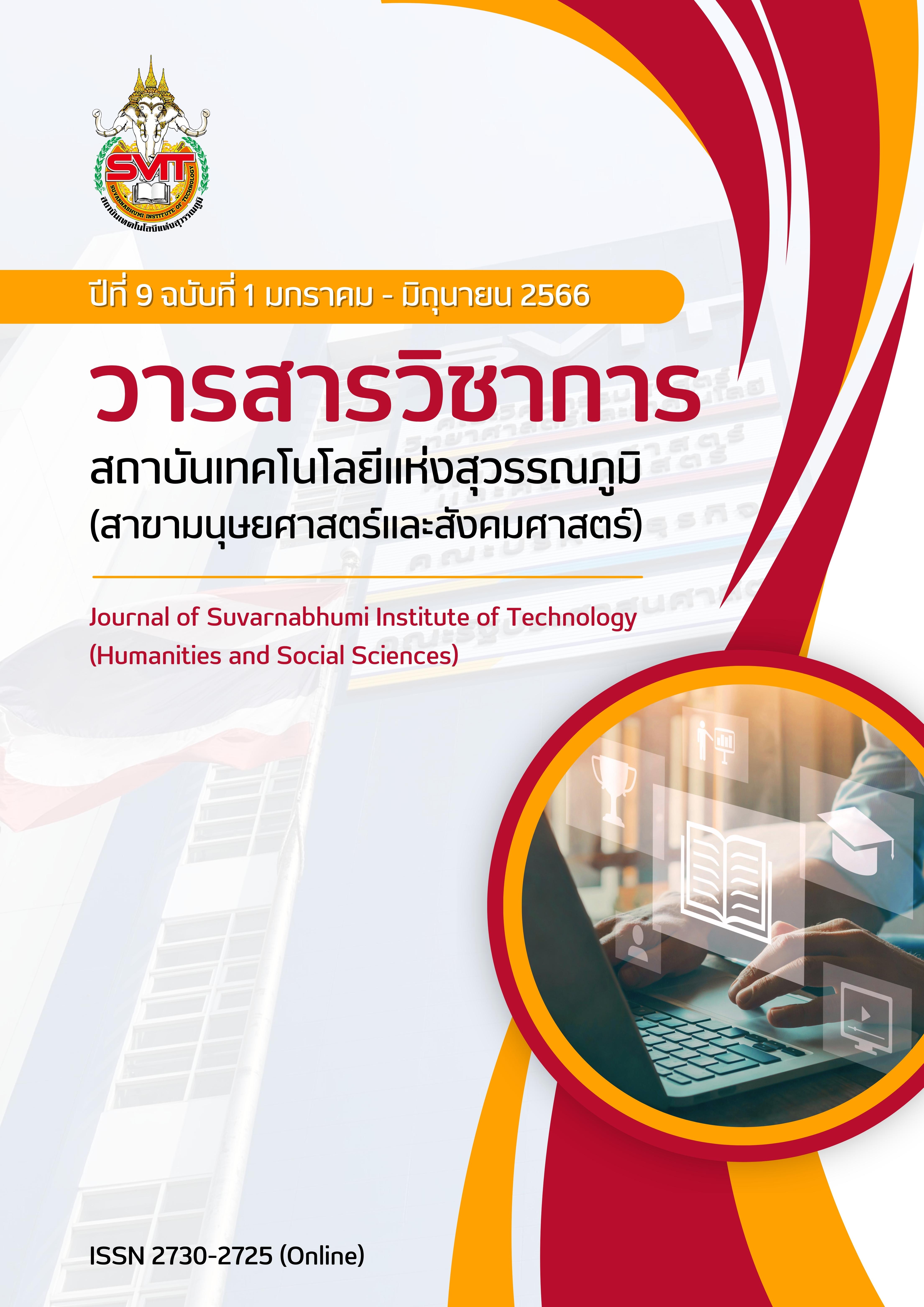ORGANIZATIONAL DEVELOPMENT STRATEGIES FOR THAI TRADITIONAL MEDICINE ESTABLISHMENTS
Keywords:
Entrepreneur, Thai traditional medicine, Organization developmentAbstract
The objective of this research was to study the strategies of organizational development of Thai traditional medical establishments on the performance of Thai traditional medicine establishments. The sample group used in this research was 312 entrepreneurs in Thai traditional medicine establishments. It was survey research and a questionnaire were used as a tool to collect data. for data analysis Using descriptive statistics such as frequency, percentage, mean and standard deviation. and inferential statistics were used to test the hypothesis using stepwise multiple regression analysis.
The results showed that the organizational development strategy, which consists of
7 areas, namely, the strategy of the organization. organizational structure Operation system in terms of management style, personnel, skills, knowledge, abilities, and shared values, there were only 3 aspects that affected the performance of Thai traditional medicine establishments, namely, personnel had a coefficient of .376 (p < .000), the shared values coefficient was .249 (p < .000), and the organizational coefficient was .122 (p < .043).
Personnel, Thai traditional medicine establishments Systematic personnel management is required. There is a staff selection system. Employee competence is developed. Is there a reward or reward? and attaches importance to human development as the most important shared values of Thai traditional medicine establishment There must be a work philosophy that everyone accepts. Have a motivational message to get everyone in the same direction. have a good organizational culture have shared values that are held together and there is something that the whole organization strives for the same thing. and organizational structure of Thai traditional medicine establishment There must be a clear chain of command. There is an organizational structure suitable for business operations. The scope of work is clearly defined. There is a centralized organizational model of decision-making power. and has a decentralized organizational model.
References
กฤษติญา มูลศร. (2562). กรอบแนวคิดแมคคินซีย์ 7s และการจัดการคุณภาพโดยรวมที่ส่งผลต่อผลสัมฤทธิ์ธุรกิจ, วารสารสหวิทยาการวิจัย, 8 (1), 40-53.
กรมการแพทย์แผนไทยและการแพทย์ทางเลือก. (2565). ประวัติและตราสัญลักษณ์. สืบค้นจาก https://www.dtam.moph.go.th/index.php?
option=com_content&view=article&id=26:hi story&catid=15&Itemid=314&lang=en
กรมสนับสนุนบริการสุขภาพ กระทรวงสาธารณสุข. (2563, 15 กรกฎาคม). จดหมาย.
กัลยา วานิชย์บัญชา. (2557). หลักสถิติ (พิมพ์ครั้งที่ 14). กรุงเทพฯ: โรงพิมพ์สามลดา.
กองเศรษฐกิจการท่องเที่ยวและกีฬา สำนักงานปลัดกระทรวงการท่องเที่ยวและกีฬา. (2562). สรุปขีดความสามารถในการแข่งขันด้านการท่องเที่ยวของประเทศ.
สืบค้นจากhttps://www.mots.go.th/old/ewt_dl_link.php?nid=12032
กองยุทธศาสตร์และแผนงาน กรมกิจการผู้สูงอายุ. (2562). สถานการณ์ สังคมสูงวัย 2561. สืบค้นจาก https://www.dop.go.th/th/know/3/127
เกษม พิพัฒน์เสรีธรรม. (2557). S.O.S. S (Strategic) O (Objective) S (Success) รหัสลับความรวย. กรุงเทพฯ: มติชน.
ชัยพัฒน์ พุฒซ้อน และกันตพัฒน์ พรศิริวัชรสิน. (2561). แนวทางการแก้ไขปัญหาสังคมผู้สูงอายุของประเทศไทย. วารสารเครือข่ายส่งเสริมการวิจัยทาง
มนุษยศาสตร์และสังคมศาสตร์, 1(1), 25-35. เซฟสิริ. (2565). WHO คืออะไร. เข้าถึงได้จาก https://www.safesiri.com/who/
ไพฑูรย์ สินลารัตน์. (2557). เพื่อความเป็นผู้นำของการครุศึกษาไทย : รวมบทบรรยายและบทความ (พิมพ์ครั้งที่ 2). กรุงเทพฯ : สำนักพิมพ์แห่งจุฬาลงกรณ์
มหาวิทยาลัย.
เยาวภา ปฐมศิริกุล. (2554). แบบจำลองปัจจัยความสำเร็จการจัดการธุรกิจบริการสุขภาพของโรงพยาบาล เอกชนในประเทศไทย, วารสารบริหารธุรกิจ, 34 (130),
-35.
ศศพร มุ่งวิชา. (2560). การพัฒนาทุนมนุษย์เพื่อส่งเสริมยุทธศาสตร์การแพทย์แผนไทยด้านเวชกรรมไทย ใน เขตพื้นที่ภาคอีสานตอนกลาง. (ดุษฎีนิพนธ์ดุษฎี
บัณฑิต, มหาวิทยาลัยเทคโนโลยีราชมงคล)
สถาบันการแพทย์ฉุกเฉินแห่งชาติ. (2565). สถานการณ์และแนวโน้มสุขภาพและการแพทย์ฉุกเฉิน (ระดับโลกและประเทศไทย). สืบค้นจาก
https://www.niems.go.th/1/UploadAttachFile/2022/EBook/414529_20220111124457. pdf
สำนักงานคณะกรรมการอาหารและยา. (ม.ป.ป.) มูลค่าการผลิตยาแผนปัจจุบันสำหรับมนุษย์แยกตามฤทธิ์ ทางเภสัชวิทยา ประจำปี 2554 -2563. สืบค้นจาก
https://www.fda.moph.go.th/sites/drug/Shared%20Documents/Statistic/Value-IATC54-63.pdf.pdf
สถาบันวิจัยเพื่อการพัฒนาประเทศไทย. (2561). รายงานการศึกษา เรื่อง ประมาณการค่าใช้จ่ายสาธารณะ ด้านสุขภาพในอีก 15 ปี ข้างหน้า. สืบค้นจาก
https://tdri.or.th/wpcontent/uploads/2019/12/ประมาณการค่าใช้จ่ายสาธารณะด้านสุขภาพ ในอีก-15-ปีข้างหน้า.pdf
สำนักงานคณะกรรมการพัฒนาการเศรษฐกิจและสังคมแห่งชาติ สำนักนายกรัฐมนตรี. (2559). แผนพัฒนา เศรษฐกิจและสังคมแห่งชาติ ฉบับที่สิบสอง พ.ศ. 2560–
สืบค้นจากhttps://www.nesdc.go.th/ewt_dl_link.php?nid=6422
เสวย อุคำพันธุ์. (2556). แนวทางการพัฒนาการให้บริการการแพทย์แผนไทยในโรงพยาบาลส่งเสริม สุขภาพตำบล กรณีศึกษาโรงพยาบาลส่งเสริมสุขภาพตำบล
อำเภอเมืองกาฬสินธุ์ จังหวัดกาฬสินธุ์. วารสารรัฐศาสตร์และนิติศาสตร์ มหาวิทยาลัยราชภัฎกาฬสินธุ์, 2 (1), 90-113.
Cronbach, L. J. (1990). Essentials of psychological testing (5th ed.). New York: Harper Collins.
Yamane, T. (1973). Statistics: An Introductory Analysis. (3rded) New York.
Harper and Row United Nations, Department of Economic and Social Affairs, Population Division (2015).Population 2030: Demographic challenges and opportunities for sustainable development planning (ST/ESA/SER.A/389), Retrieved from
https://www.un.org/en/development/desa/population/publications/pdf/trends/Population2030.pdf.
World Health Organization (2016). Traditional medicine in kingdom of Thailand, SEARO. Retrieved from
https://apps.who.int/iris/bitstream/handle/10665/258886/sea-hsd-393.pdf?sequence=1&isAllowed=y.
Downloads
Published
Issue
Section
License
Copyright (c) 2023 Suvarnabhumi Institute of Technology

This work is licensed under a Creative Commons Attribution-NonCommercial-NoDerivatives 4.0 International License.
บทความที่ได้รับการตีพิมพ์เป็นลิขสิทธิ์ของวารสารวิชาการ สถาบันเทคโนโลยีแห่งสุวรรณภูมิ
ข้อความที่ปรากฏในบทความแต่ละเรื่องในวารสารวิชาการเล่มนี้เป็นความคิดเห็นส่วนตัวของผู้เขียนแต่ละท่านไม่เกี่ยวข้องกับสถาบันเทคโนโลยีแห่งสุวรรณภูมิ และคณาจารย์ท่านอื่นๆในสถาบันฯ แต่อย่างใด ความรับผิดชอบองค์ประกอบทั้งหมดของบทความแต่ละเรื่องเป็นของผู้เขียนแต่ละท่าน หากมีความผิดพลาดใดๆ ผู้เขียนแต่ละท่านจะรับผิดชอบบทความของตนเองแต่ผู้เดียว





